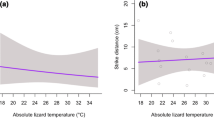Abstract
Pitvipers (Crotalinae) and boid snakes (Boidae) possess highly sensitive infrared (IR) receptors. The ability of these snakes to image IR radiation allows the assessment of the direction and distance of an IR source (such as warm-blooded prey) in the absence of visual cues. The aim of this study was to determine the behavioural threshold of snakes to an IR stimulus. A moving IR source of constant size and temperature was presented to rattlesnakes (Crotalus atrox) at various distances (10–160 cm) from their snout. The snakes’ responses were quantified by measuring distinct behavioural changes during stimulus presentation (head jerks, head fixed, freezing, rattling and tongue-flicking). The results revealed that C. atrox can detect an artificial IR stimulus resembling a mouse in temperature and size up to a distance of 100 cm, which corresponds to a radiation density of 3.35 × 10−3 mW/cm2. These behavioural results reveal a 3.2 times higher sensitivity to IR radiation than earlier electrophysiological investigations.



Similar content being viewed by others
References
Barrett R (1970) The pit organs of snakes. In: Gans C (ed) Biology of the reptilia. Academic, New York, pp 277–300
Bleckmann H (1980) Reaction time and stimulus frequency in prey localization in the surface-feeding fish Aplocheilus lineatus. J Comp Physiol A 140:163–172
Bleckmann H (1994) Reception of hydrodynamic stimuli in aquatic and semiaquatic animals. Gustav Fischer, Stuttgart
Bullock TH, Barrett R (1968) Radiant heat reception in snakes. Commun Behav Biol Part A 1:19–29
Bullock TH, Cowles RB (1952) Physiology of an infrared receptor: the facial pit of pit vipers. Science 115:541–543
Bullock TH, Diecke FPJ (1956) Properties of an infra-red receptor. Science 124:281–282
Campbell AL, Naik RR, Sowards L, Stone MO (2002) Biological infrared imaging and sensing. Micron 33:211–225
Chiszar D, Castro CA, Smith HM, Guyon C (1986) A behavioral method for assessing utilization of thermal cues by snakes during feeding episodes with a comparison of crotaline and viperine species. Ann Zool 24:123–131
de Cock Buning TJ (1983a) Thermal sensitivity as a specialization for prey capture and feeding in snakes. Am Zool 23:363–375
de Cock Buning TJ (1983b) Thresholds of infrared sensitive tectal neurons in Python reticulatus, Boa constrictor and Agkistrodon rhodostoma. J Comp Physiol A 151:461–467
de Cock Buning TJ, Goris RC, Terashima S (1981a) The role of thermosensitivity in the feeding behavior of the pit viper Agkistrodon blomhoffi brevicaudus. Jap J Herpetol 9:7–27
de Cock Buning TJ, Terashima S, Goris RC (1981b) Crotaline pit organs analysed as warm receptors. Cell Mol Neurobiol 1:69–85
Goris RC, Nomoto M (1967) Infrared reception in oriental crotaline snakes. Comp Biochem Physiol 23:879–892
Grace MS, Woodward OM (2001) Altered visual experience and acute visual deprivation affect predatory targeting by infrared-imaging boid snakes. Brain Res 919:250–258
Grace MS, Woodward OM, Church DR, Calisch G (2001) Prey targeting by the infrared-imaging snake python: effects of experimental and congenital visual deprivation. Behav Brain Res 119:23–31
Greene HW (1992) The ecological and behavioral context for pitviper evolution. In: Campbell JA, Brodie ED (eds) Biology of the pitvipers. Selva, Texas, pp 107–118
Haverly JE, Kardong KV (1996) Sensory deprivation effects on the predatory behavior of the rattlesnake Crotalus viridis oreganus. Copeia 2:419–428
Jones BS, Lynn WF, Stone MO (2001) Thermal modelling of snake infrared reception: evidence for limited detection range. J Theor Biol 209:201–211
Kardong KV (1993) The predatory behavior of the northern pacific rattlesnake (Crotalus viridis oreganus)—laboratory versus wild mice as prey. Herpetologica 49:457–463
Kardong KV, Mackessy SP (1991) The strike behavior of a congenitally blind rattlesnake. J Herpetol 25:208–211
Krochmal AR, Bakken GS (2000) Evidence for the use of facial pits for behavioral thermoregulation in the western diamondback rattlesnakes (Crotalus atrox). Am Zool 40:1092–1093
Krochmal AR, Bakken GS (2003) Thermoregulation is the pits: use of thermal radiation for retreat site selection by rattlesnakes. J Exp Biol 206:2539–2545
Krochmal AR, Bakken GS, LaDuc TJ (2004) Heat in evolution’s kitchen: evolutionary perspectives on the functions and origin of the facial pit of pitvipers (Viperidae: Crotalinae). J Exp Biol 207:4231–4238
Moiseenkova V, Bell B, Motamedi M, Wozniak E, Christensen B (2003) Wide-band spectral tuning of heat receptors in the pit organ of the copperhead snake (Crotalinae). Am J Physiol Regul Integr Comp Physiol 284:598–606
Molenaar GJ (1992) Anatomy and physiology of infrared sensitivity of snakes. In: Gans C (ed) Biology of the reptilia. University of Chicago Press, Chicago, pp 368–453
Noble GK, Schmidt A (1937) The structure and function of the facial and labial pits of snakes. Proc Am Phil Soc 77:263–288
Ross M (1935) Die Lippengruben der Pythonen als Temperaturorgane. Jena Z Naturw 63:1–32
Sexton OJ, Jacobson P, Bramble JE (1992) Geographic variation in some activities associated with hibernation in nearctic pitvipers. In: Campbell JA, Brodie ED (eds) Biology of the pitvipers. Selva, Texas, pp 337–345
Tennant A, Bartlett RD (2000) Snakes of North America: eastern and central regions. Gulf Publishing, Houston
Terashima S-I, Goris RC, Katsuki Y (1968) Generator potential of crotaline snake infrared receptor. J Neurophysiol 31:682–688
Theodoratus DH, Chiszar D, Smith HM (1997) Rattlesnake orientation to prey as a function of thermal backgrounds and edges. Physiol Record 47:461–472
Young BA, Aguiar A (2002) Response of western diamondback rattlesnakes Crotalus atrox to airborne sounds. J Exp Biol 205:3087–3092
Acknowledgements
For their critical comments we wish to thank Horst Bleckmann and Michael Hofmann. We are also very grateful to Bruce Young for his valuable advice and critical reading of the manuscript. This study was supported by the German Science Foundation (WE 2835).
Author information
Authors and Affiliations
Corresponding author
Rights and permissions
About this article
Cite this article
Ebert, J., Westhoff, G. Behavioural examination of the infrared sensitivity of rattlesnakes (Crotalus atrox). J Comp Physiol A 192, 941–947 (2006). https://doi.org/10.1007/s00359-006-0131-8
Received:
Revised:
Accepted:
Published:
Issue Date:
DOI: https://doi.org/10.1007/s00359-006-0131-8




